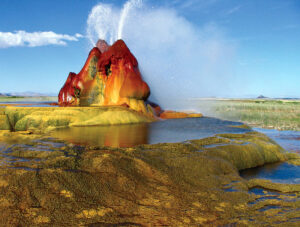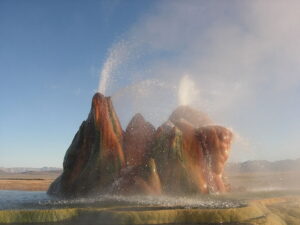 When I think of geysers, Old Faithful Geyser in Yellowstone National Park immediately comes to my mind. Of course, there are many other geysers in Yellowstone National Park, and there are also geysers in other parts of the world. Most geysers occur naturally, but there is such a thing as a man-made geyser too. I never really knew that before. I guess I wonder, why anyone would “make” a geyser. Somehow, I have a feeling that it wasn’t exactly an intentional project.
When I think of geysers, Old Faithful Geyser in Yellowstone National Park immediately comes to my mind. Of course, there are many other geysers in Yellowstone National Park, and there are also geysers in other parts of the world. Most geysers occur naturally, but there is such a thing as a man-made geyser too. I never really knew that before. I guess I wonder, why anyone would “make” a geyser. Somehow, I have a feeling that it wasn’t exactly an intentional project.
One such man-made geyser is the Fly Geyser, which can be found on the edge of the Black Rock Desert. As tourist attractions go, this is one of the coolest. It was created 100 years ago in Nevada, but how was it created exactly? The geyser itself is very unusual, but minerals can create strange looking things. Before Fly Geyser became the colorful geyser we see today, it was simply a well, man-made in the 1900s. The well was dug in an effort to get irrigation water for the area. Then heated water shot out through the cracks. When geothermal water at close to the boiling point was found, the well was abandoned. Of course, the water was similar to that of the waters in Yellowstone, but not quite as hot. The minerals began to deposit on the surface of the ground, forming the 10 to 12 foot mound and the various terraces. Thermophilic algae gives the mound its beautiful red and greens streaks, which is the prettiest part of the geyser.
Fly Geyser is also known as Fly Ranch Geyser because it is located on the Fly Ranch on Nevada State Route 34, due east of Black Rock Desert and about 20 miles north of Gerlach, Nevada. Fly Geyser is located near the edge of Fly Reservoir in the Hualapai Flat Geothermal Flats and is approximately 5 feet high by 12 feet wide, counting the mound on which it sits. The source of the Fly Geyser field’s heat is attributed to a very deep pool  of hot rock where tectonic rifting and faulting are common. In 1964 a geothermic energy company drilled a second well near the site of the first well. The water was not hot enough for energy purposes. They reportedly capped the well, but the seal failed. The discharge from the second well released sufficient pressure that the original geyser dried up.
of hot rock where tectonic rifting and faulting are common. In 1964 a geothermic energy company drilled a second well near the site of the first well. The water was not hot enough for energy purposes. They reportedly capped the well, but the seal failed. The discharge from the second well released sufficient pressure that the original geyser dried up.
These days the Fly Geyser is a tourist attraction, Fly Ranch is open to small, guided three-hour nature walks from April to October of each year. The geyser is part of the nature walk. I love hiking, and I can only imagine how awesome it would be to hike out to a geyser…especially one as beautiful as the Fly Geyser.


Leave a Reply